Karan Sapra
Nemotron-H: A Family of Accurate and Efficient Hybrid Mamba-Transformer Models
Apr 10, 2025

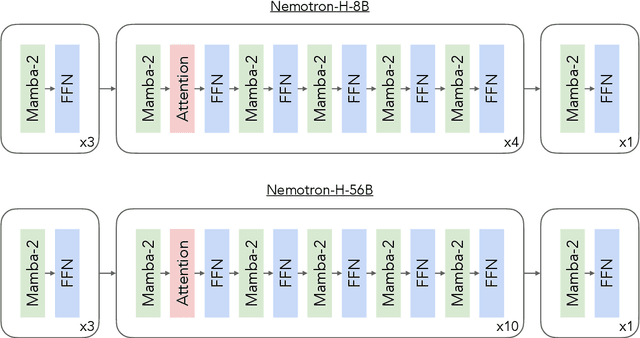
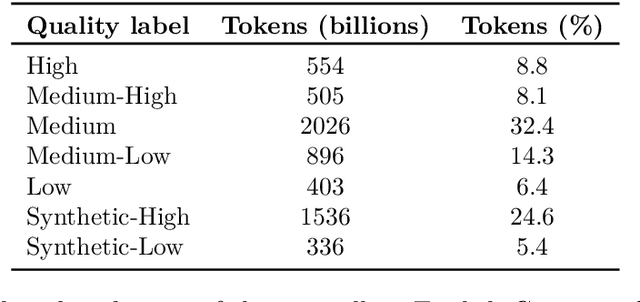
Abstract:As inference-time scaling becomes critical for enhanced reasoning capabilities, it is increasingly becoming important to build models that are efficient to infer. We introduce Nemotron-H, a family of 8B and 56B/47B hybrid Mamba-Transformer models designed to reduce inference cost for a given accuracy level. To achieve this goal, we replace the majority of self-attention layers in the common Transformer model architecture with Mamba layers that perform constant computation and require constant memory per generated token. We show that Nemotron-H models offer either better or on-par accuracy compared to other similarly-sized state-of-the-art open-sourced Transformer models (e.g., Qwen-2.5-7B/72B and Llama-3.1-8B/70B), while being up to 3$\times$ faster at inference. To further increase inference speed and reduce the memory required at inference time, we created Nemotron-H-47B-Base from the 56B model using a new compression via pruning and distillation technique called MiniPuzzle. Nemotron-H-47B-Base achieves similar accuracy to the 56B model, but is 20% faster to infer. In addition, we introduce an FP8-based training recipe and show that it can achieve on par results with BF16-based training. This recipe is used to train the 56B model. All Nemotron-H models will be released, with support in Hugging Face, NeMo, and Megatron-LM.
AIDE: Agentically Improve Visual Language Model with Domain Experts
Feb 13, 2025



Abstract:The enhancement of Visual Language Models (VLMs) has traditionally relied on knowledge distillation from larger, more capable models. This dependence creates a fundamental bottleneck for improving state-of-the-art systems, particularly when no superior models exist. We introduce AIDE (Agentic Improvement through Domain Experts), a novel framework that enables VLMs to autonomously enhance their capabilities by leveraging specialized domain expert models. AIDE operates through a four-stage process: (1) identifying instances for refinement, (2) engaging domain experts for targeted analysis, (3) synthesizing expert outputs with existing data, and (4) integrating enhanced instances into the training pipeline. Experiments on multiple benchmarks, including MMMU, MME, MMBench, etc., demonstrate AIDE's ability to achieve notable performance gains without relying on larger VLMs nor human supervision. Our framework provides a scalable, resource-efficient approach to continuous VLM improvement, addressing critical limitations in current methodologies, particularly valuable when larger models are unavailable to access.
Éclair -- Extracting Content and Layout with Integrated Reading Order for Documents
Feb 06, 2025



Abstract:Optical Character Recognition (OCR) technology is widely used to extract text from images of documents, facilitating efficient digitization and data retrieval. However, merely extracting text is insufficient when dealing with complex documents. Fully comprehending such documents requires an understanding of their structure -- including formatting, formulas, tables, and the reading order of multiple blocks and columns across multiple pages -- as well as semantic information for detecting elements like footnotes and image captions. This comprehensive understanding is crucial for downstream tasks such as retrieval, document question answering, and data curation for training Large Language Models (LLMs) and Vision Language Models (VLMs). To address this, we introduce \'Eclair, a general-purpose text-extraction tool specifically designed to process a wide range of document types. Given an image, \'Eclair is able to extract formatted text in reading order, along with bounding boxes and their corresponding semantic classes. To thoroughly evaluate these novel capabilities, we introduce our diverse human-annotated benchmark for document-level OCR and semantic classification. \'Eclair achieves state-of-the-art accuracy on this benchmark, outperforming other methods across key metrics. Additionally, we evaluate \'Eclair on established benchmarks, demonstrating its versatility and strength across several evaluation standards.
OMCAT: Omni Context Aware Transformer
Oct 15, 2024



Abstract:Large Language Models (LLMs) have made significant strides in text generation and comprehension, with recent advancements extending into multimodal LLMs that integrate visual and audio inputs. However, these models continue to struggle with fine-grained, cross-modal temporal understanding, particularly when correlating events across audio and video streams. We address these challenges with two key contributions: a new dataset and model, called OCTAV and OMCAT respectively. OCTAV (Omni Context and Temporal Audio Video) is a novel dataset designed to capture event transitions across audio and video. Second, OMCAT (Omni Context Aware Transformer) is a powerful model that leverages RoTE (Rotary Time Embeddings), an innovative extension of RoPE, to enhance temporal grounding and computational efficiency in time-anchored tasks. Through a robust three-stage training pipeline-feature alignment, instruction tuning, and OCTAV-specific training-OMCAT excels in cross-modal temporal understanding. Our model demonstrates state-of-the-art performance on Audio-Visual Question Answering (AVQA) tasks and the OCTAV benchmark, showcasing significant gains in temporal reasoning and cross-modal alignment, as validated through comprehensive experiments and ablation studies. Our dataset and code will be made publicly available. The link to our demo page is https://om-cat.github.io.
Eagle: Exploring The Design Space for Multimodal LLMs with Mixture of Encoders
Aug 28, 2024



Abstract:The ability to accurately interpret complex visual information is a crucial topic of multimodal large language models (MLLMs). Recent work indicates that enhanced visual perception significantly reduces hallucinations and improves performance on resolution-sensitive tasks, such as optical character recognition and document analysis. A number of recent MLLMs achieve this goal using a mixture of vision encoders. Despite their success, there is a lack of systematic comparisons and detailed ablation studies addressing critical aspects, such as expert selection and the integration of multiple vision experts. This study provides an extensive exploration of the design space for MLLMs using a mixture of vision encoders and resolutions. Our findings reveal several underlying principles common to various existing strategies, leading to a streamlined yet effective design approach. We discover that simply concatenating visual tokens from a set of complementary vision encoders is as effective as more complex mixing architectures or strategies. We additionally introduce Pre-Alignment to bridge the gap between vision-focused encoders and language tokens, enhancing model coherence. The resulting family of MLLMs, Eagle, surpasses other leading open-source models on major MLLM benchmarks. Models and code: https://github.com/NVlabs/Eagle
Personalized Federated Learning with First Order Model Optimization
Jan 28, 2021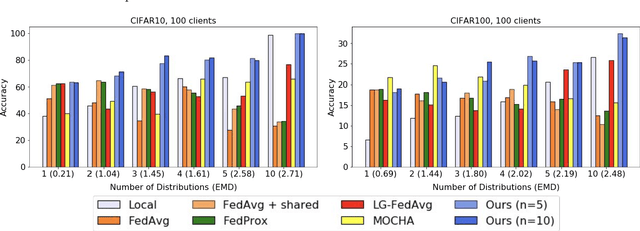
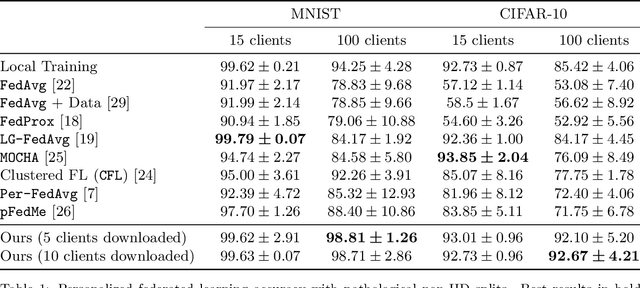

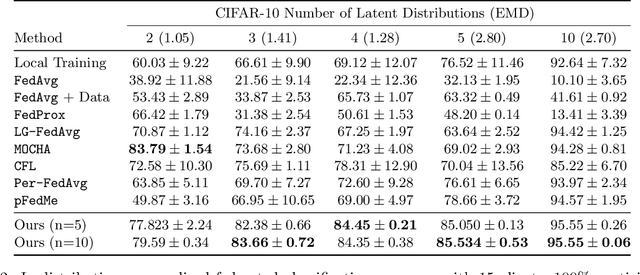
Abstract:While federated learning traditionally aims to train a single global model across decentralized local datasets, one model may not always be ideal for all participating clients. Here we propose an alternative, where each client only federates with other relevant clients to obtain a stronger model per client-specific objectives. To achieve this personalization, rather than computing a single model average with constant weights for the entire federation as in traditional FL, we efficiently calculate optimal weighted model combinations for each client, based on figuring out how much a client can benefit from another's model. We do not assume knowledge of any underlying data distributions or client similarities, and allow each client to optimize for arbitrary target distributions of interest, enabling greater flexibility for personalization. We evaluate and characterize our method on a variety of federated settings, datasets, and degrees of local data heterogeneity. Our method outperforms existing alternatives, while also enabling new features for personalized FL such as transfer outside of local data distributions.
World-Consistent Video-to-Video Synthesis
Jul 16, 2020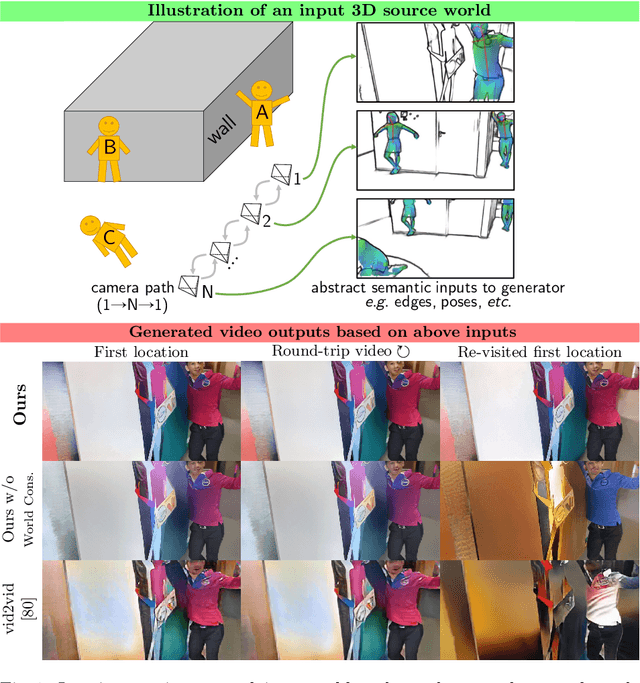
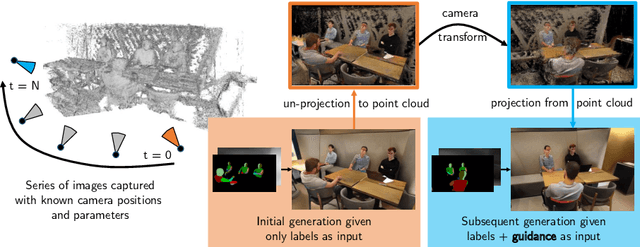
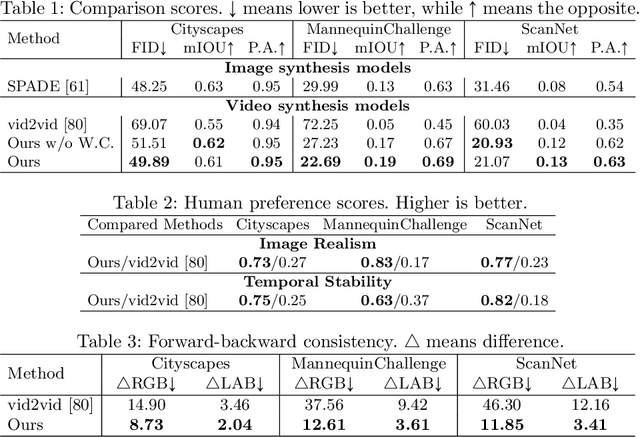
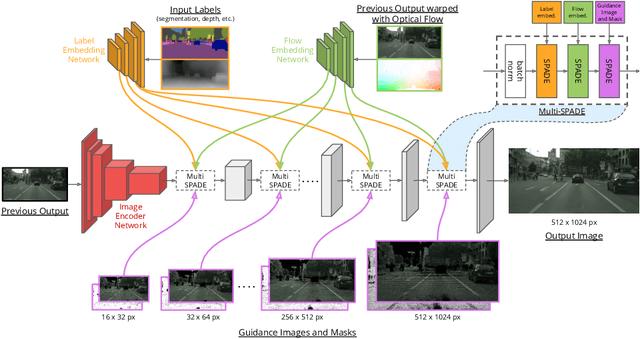
Abstract:Video-to-video synthesis (vid2vid) aims for converting high-level semantic inputs to photorealistic videos. While existing vid2vid methods can achieve short-term temporal consistency, they fail to ensure the long-term one. This is because they lack knowledge of the 3D world being rendered and generate each frame only based on the past few frames. To address the limitation, we introduce a novel vid2vid framework that efficiently and effectively utilizes all past generated frames during rendering. This is achieved by condensing the 3D world rendered so far into a physically-grounded estimate of the current frame, which we call the guidance image. We further propose a novel neural network architecture to take advantage of the information stored in the guidance images. Extensive experimental results on several challenging datasets verify the effectiveness of our approach in achieving world consistency - the output video is consistent within the entire rendered 3D world. https://nvlabs.github.io/wc-vid2vid/
Transposer: Universal Texture Synthesis Using Feature Maps as Transposed Convolution Filter
Jul 14, 2020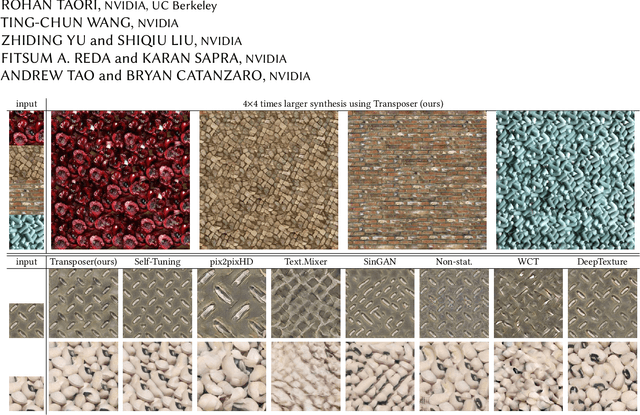
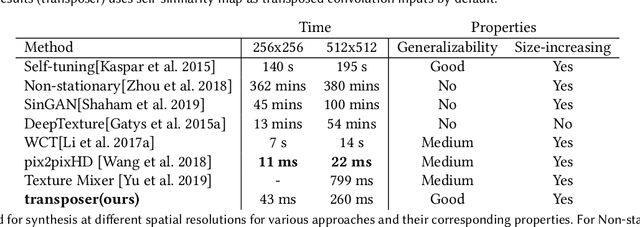
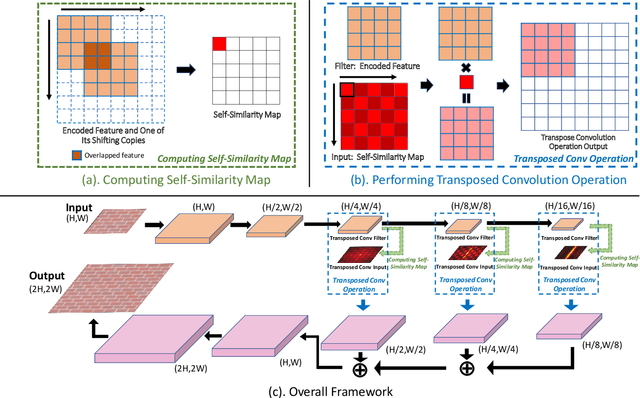
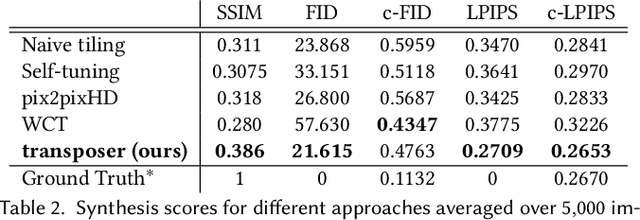
Abstract:Conventional CNNs for texture synthesis consist of a sequence of (de)-convolution and up/down-sampling layers, where each layer operates locally and lacks the ability to capture the long-term structural dependency required by texture synthesis. Thus, they often simply enlarge the input texture, rather than perform reasonable synthesis. As a compromise, many recent methods sacrifice generalizability by training and testing on the same single (or fixed set of) texture image(s), resulting in huge re-training time costs for unseen images. In this work, based on the discovery that the assembling/stitching operation in traditional texture synthesis is analogous to a transposed convolution operation, we propose a novel way of using transposed convolution operation. Specifically, we directly treat the whole encoded feature map of the input texture as transposed convolution filters and the features' self-similarity map, which captures the auto-correlation information, as input to the transposed convolution. Such a design allows our framework, once trained, to be generalizable to perform synthesis of unseen textures with a single forward pass in nearly real-time. Our method achieves state-of-the-art texture synthesis quality based on various metrics. While self-similarity helps preserve the input textures' regular structural patterns, our framework can also take random noise maps for irregular input textures instead of self-similarity maps as transposed convolution inputs. It allows to get more diverse results as well as generate arbitrarily large texture outputs by directly sampling large noise maps in a single pass as well.
Hierarchical Multi-Scale Attention for Semantic Segmentation
May 21, 2020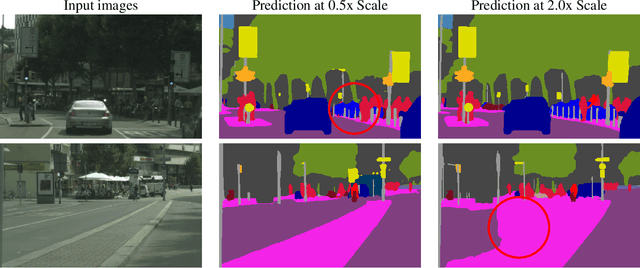

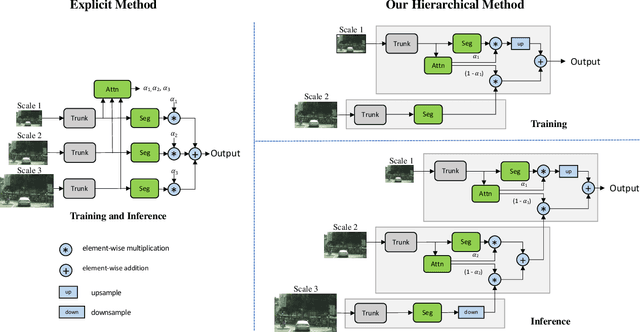

Abstract:Multi-scale inference is commonly used to improve the results of semantic segmentation. Multiple images scales are passed through a network and then the results are combined with averaging or max pooling. In this work, we present an attention-based approach to combining multi-scale predictions. We show that predictions at certain scales are better at resolving particular failures modes, and that the network learns to favor those scales for such cases in order to generate better predictions. Our attention mechanism is hierarchical, which enables it to be roughly 4x more memory efficient to train than other recent approaches. In addition to enabling faster training, this allows us to train with larger crop sizes which leads to greater model accuracy. We demonstrate the result of our method on two datasets: Cityscapes and Mapillary Vistas. For Cityscapes, which has a large number of weakly labelled images, we also leverage auto-labelling to improve generalization. Using our approach we achieve a new state-of-the-art results in both Mapillary (61.1 IOU val) and Cityscapes (85.1 IOU test).
Panoptic-based Image Synthesis
Apr 21, 2020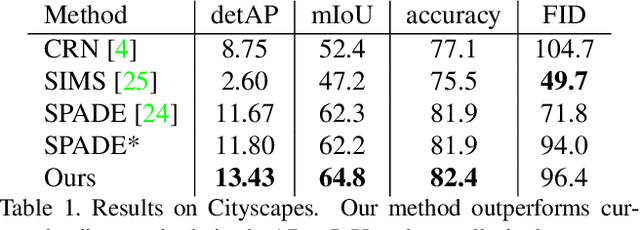
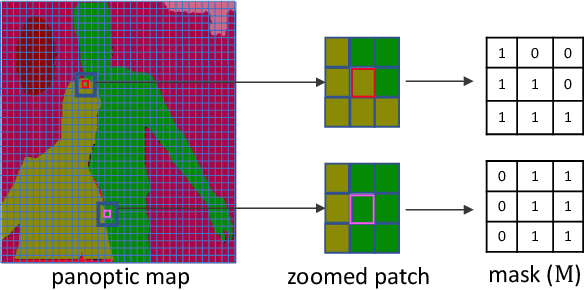

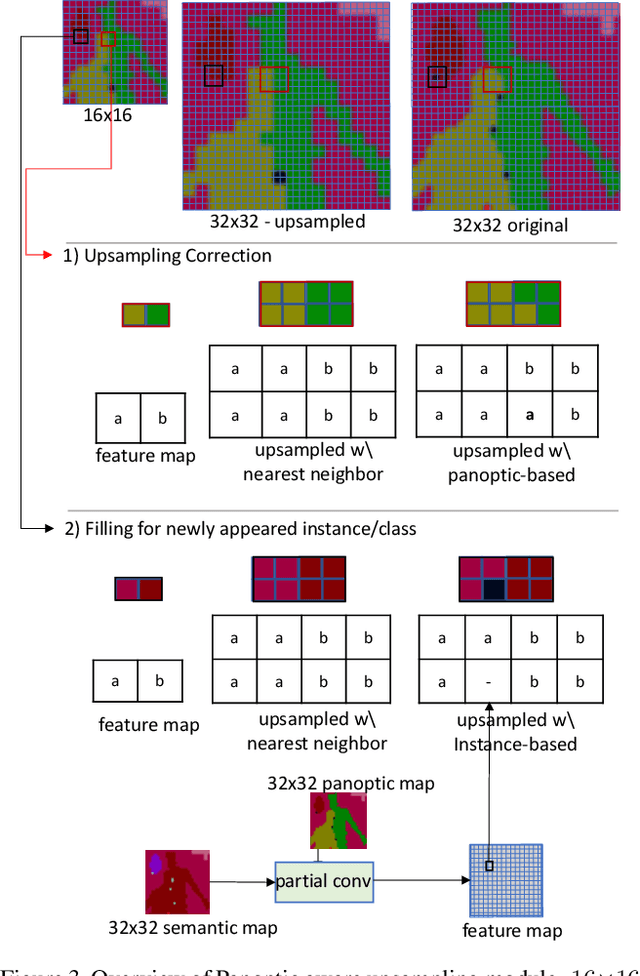
Abstract:Conditional image synthesis for generating photorealistic images serves various applications for content editing to content generation. Previous conditional image synthesis algorithms mostly rely on semantic maps, and often fail in complex environments where multiple instances occlude each other. We propose a panoptic aware image synthesis network to generate high fidelity and photorealistic images conditioned on panoptic maps which unify semantic and instance information. To achieve this, we efficiently use panoptic maps in convolution and upsampling layers. We show that with the proposed changes to the generator, we can improve on the previous state-of-the-art methods by generating images in complex instance interaction environments in higher fidelity and tiny objects in more details. Furthermore, our proposed method also outperforms the previous state-of-the-art methods in metrics of mean IoU (Intersection over Union), and detAP (Detection Average Precision).
 Add to Chrome
Add to Chrome Add to Firefox
Add to Firefox Add to Edge
Add to Edge